Crashes related to the consumption of alcohol have long plagued the United States. Even in the modern age of Uber, Lyft, and other low-cost ridesharing options, some still make the decision to consume, perhaps even over-consume, alcohol, and get behind the wheel.
Every year during the holidays The Beliz Law Firm has offered free cab rides to get home safe. Find out more information here.
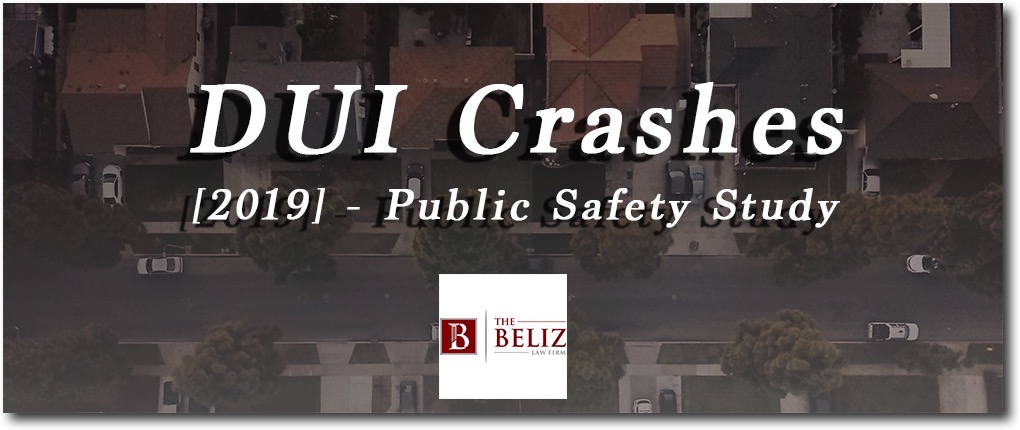
The recent trend of DUI injury accidents in Long Beach, California, shows that such horrific and entirely preventable incidents are on the rise. In 2016, the last year for which the California Office of Traffic Safety (OTS) has data available, 304 collisions in the city of Long Beach were ‘alcohol involved.’
That means that more than 10% of collisions in the LBC involved alcohol and those who had consumed it shortly prior to the wreck.
Obviously, collisions related to drinking and driving remain a very serious problem in the city, in Los Angeles County, and in California as a whole, especially as crashes related to driving under the influence continue to trend upwards. In 2015, Long Beach had 278 such collisions. In 2014, OTS defined 230 collisions in city limits as related to alcohol. The number of DUI-related crashes in the city has been on the rise, steadily, since 2011.
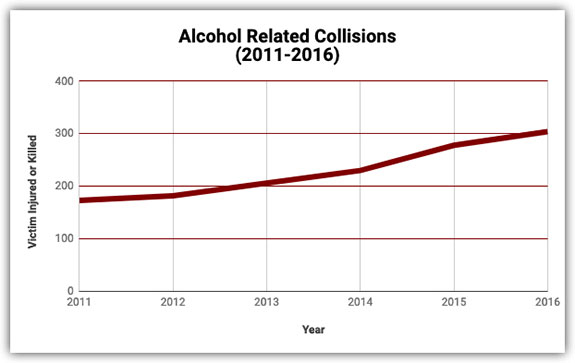
Mapping Long Beach Driving Under Influence Injuries
For those hoping to avoid a similar collision, mapping the collisions in 2016 shows a handful of interesting patterns, and provides information about areas that appear to be ‘hotspots’ for wrecks involving those who consumed alcohol before driving.
When viewing the data on a map, a number of problem stretches of road and intersections appear.
Alcohol Related Collisions 01/01/2016 – 12/31/2016
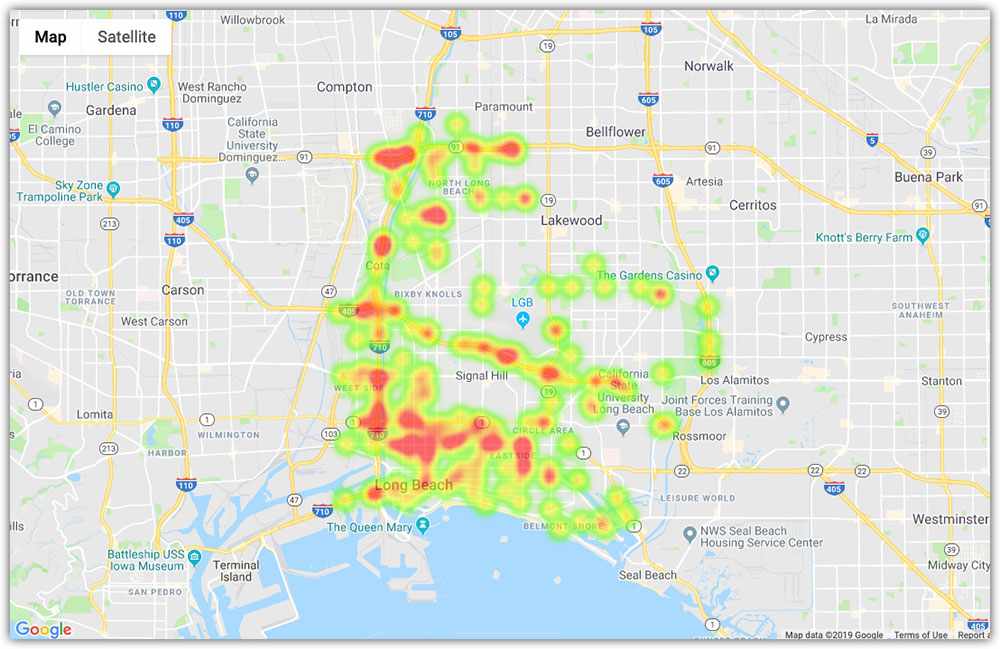
Source: TIMS.com
Dangerous Stretches Of Road
When the data is properly mapped out, some portions of the street seem to be a bit more dangerous than others.
The major highways and freeways which run through the Long Beach corporate limits all have a large number of DUI incidents recorded on them in the 2016’s statistics. There is a correlation with more drivers that use a certain roadway; the more likely any type of collision will happen. Therefore since the San Diego (Interstate 405) and the Long Beach (Interstate 710) freeways have the most traffic, both have the highest numbers of DUI crashes.
In 2016, the Long Beach Freeway saw 24 collisions that the OTS said were ‘alcohol involved’ in nature, which produced one death and 29 injuries.
That same year, the San Diego Freeway was home to 20 collisions involving alcohol, which caused one death and 23 injuries.
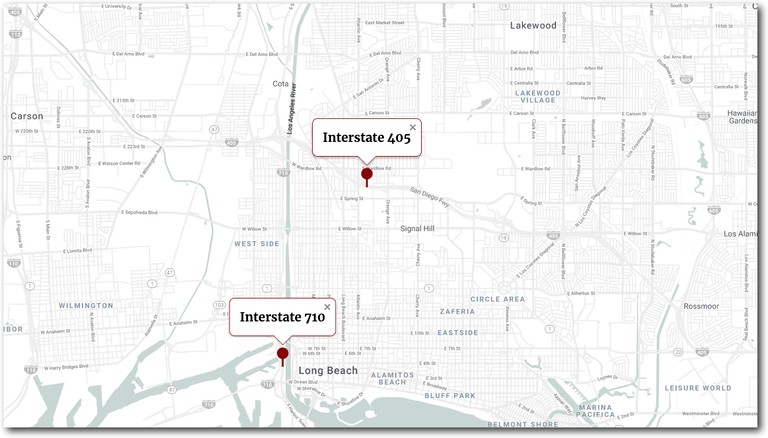
However, some short stretches of road were home to a surprising number of collisions as well.
One block of West Anaheim Street was home to three alcohol-related collisions, which caused three injuries. The entirety of Anaheim Street saw 17 collisions in 2016, including one death and 16 injuries.
Long Beach Boulevard was also home to a large number of such collisions, with nine crashes that produced 15 injuries, but no deaths. One particular crash shortly before Thanksgiving 2016 involved five injuries alone!
Redondo Avenue was also home to a large number of collisions, specifically between Anaheim Street and 7th Street. In less than a mile, there were six collisions involving alcohol. Luckily, these incidents caused only six injuries and no deaths.
A stretch of Carson Street just over half a mile in length was home to two severe collisions involving alcohol, each of which took one life and injured one person.
Dangerous Intersections
As some stretches of the road appear more dangerous than others, some intersections and their immediate surroundings appear more prone to collisions related to alcohol.
The intersections of Anaheim Street and Redondo Avenue and Anaheim Street and 11th Street were both the site for two collisions apiece, and two injuries each.
The intersection of East Market Street and Lime Avenue saw the same number of collisions and the same number of injuries.
Thankfully, it seems that most intersections are relatively free of collisions, or are only home to, at most, two.
Severe Collisions
For the purposes of record keeping, all reported collisions receive a severity rating between 1 and 4. Collisions rated 4 produced an injury, which consists of a complaint of pain (for example neck pain or back pain). Those given a rating of 3 produced some sort of ‘other visible’ injury. Collisions that earn a severity rating of 2 produced a severe injury like a fracture or broken bone.
A wreck with a collision severity of 1 produced at least one fatality.
Thankfully, there were only 12 such collisions related to alcohol in Long Beach, California, during 2016. These 12 automobile wrecks took 12 lives and injured four people as well.
What the Numbers Say About Alcohol-Related Collisions
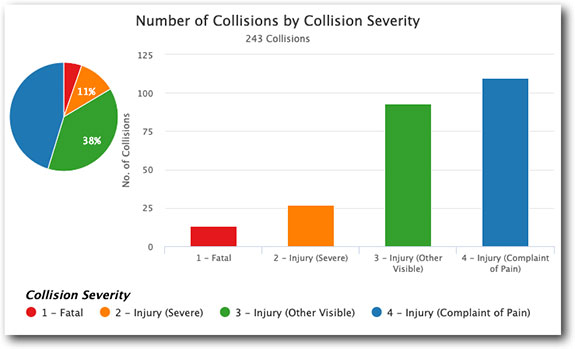
Of these most severe collisions, ratings with a 1, four of them took place on major roads and freeways. This may be due to more traffic and higher speed limits.
Strangely, two of these severe collisions which included fatalities occurred less than a mile apart, on East Carson Street, between Clark Avenue and San Anseline Avenue.
For a city with so many accidents related to driving under the influence, this number is quite small, representing less than one out of every 20 alcohol-related collisions. However, that is likely no consolation to the families of the deceased.
Moving Forward
What can the city, the government, and the people do to reverse the disturbing trend of consistent increases in alcohol-related collisions in the area?
Firstly, the education that drinking and driving should not be mixed together. That is a driver is to consume alcohol then that person should avoid driving a vehicle and hand his or her keys to a designated driver.
Designated drivers can be a friend or relative. However, with technology designated drivers can be reached via a smartphone. The low cost of services like Uber and Lyft make it much cheaper to get home after a night out on the town.
Additionally, some schools, churches, and even non-profit organizations funded free rides on certain days, including New Years and St. Patrick’s Day, during 2017 and 2018, around the country.
Colleges around the country are in the process of developing or have already developed, programs to retrieve their students after a night of drinking. These programs vary from school to school, but most agree that the programs helped to decrease drunk driving collisions and arrests related to driving under the influence.
Although it is not a solution currently, in the future, self-driving vehicles could be a solution to alcohol-related accidents. An inebriated person may be able to fall asleep while their car takes them safely home.
In the end, hopefully, the combination of education, technology, and community outreach will help lower the number of DUI crashes in and around the streets and intersections of California. The Beliz Law Firm will continue to offer its own rating for the most dangerous cities for drivers in California.
Have a question about the study? Email Us
